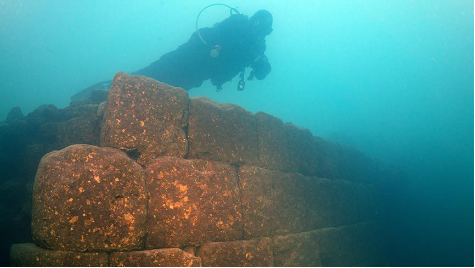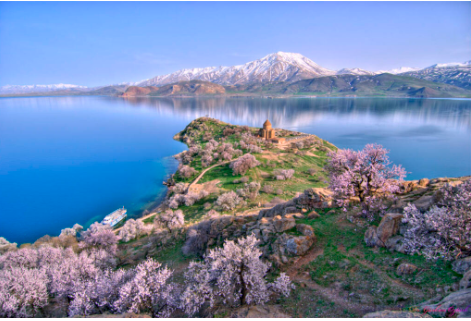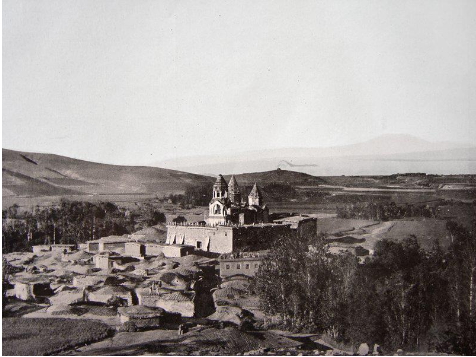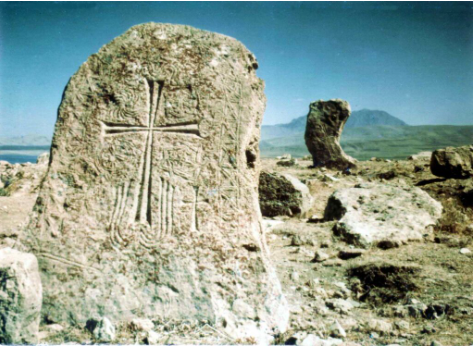
The remains of a possibly 3,000-year-old fortress from the Armenian kingdom of Urartu (Ararat) have been found submerged underwater in Lake Van by a team of Turkish archaeologists.
The governorship of Bitlis Province in eastern Turkey and Van Yüzüncü Yıl University oversaw the underwater excavations. The Iron Age Armenian culture, sometimes referred to as the Kingdom of Van, Urartu, Ararat, and Armenia, is supposed to have owned the castle.
It is thought that the lake was created by a crater left behind by Mount Nemrut’s volcanic eruption close to the province of Van. Compared to the Iron Age, the reservoir’s water level is currently 150 meters higher.

According to Tahsin Ceylan, a newspaper researcher.
To fully understand the significance of this discovery, the experts plan to carry out additional excavations. Travelers are anticipated to be drawn to the finding.
The town of Van and the Lake are the ancient center of Armenian civilization, even though they are currently part of the Republic of Turkey. Indeed, it is thought to be the exact location where the Armenian ethnic identity originated. The mythological founder of the Armenian people, Hayk, is said to have settled close to Lake Van in 2492 BC, when he initially established the settlement of Haykashen and erected the formidable castle of Haykaberd, according to the writings of the 5th-century Armenian historian Movses of Khorene.
Van Hayk gathered his army at the very edge of the lake, telling them that they would rather die fighting to overthrow the Babylonian tyrant king Bel than become his slaves. Bel had marched against him and his people. Hayk finally vanquished Bel at the Dyutsaznamart (meaning: “Battle of Giants”) near Lake Van. The region where the battle took place was subsequently dubbed Hayots Dzor, which means “Valley of the Armenians,” after Hayk. As a result, the Armenian people named themselves Hay and their nation Hayk, or Hayastan, in remembrance of their fabled founder Hayk. The Armenian nation and its first free kingdom were founded just on the shores of Lake Van.

According to the ancient Hittite inscriptions deciphered by Emil Forrer, a Swiss scholar, in the 1920s, there was a mountain nation named “Hayasa” with a vessel located near Lake Van. The campaigns of Mursili against Hayasa are chronicled in the 14th-century BC Annals of Mursili:
The chief cupbearer Nuvanza and all the noblemen came to receive me at Tiggaramma when I arrived. “The season is now far advanced, Sire, Lord!” the chiefs told me, although I still should have marched to Hayasa. Avoid visiting Hayasa. Furthermore, I skipped Hayasa.

The Armenian kingdom of Van (Urartu) was first discovered thanks to the efforts of Movses of Khorene. Science was unaware of this kingdom’s existence until 1823, when J. Saint-Martin, a French scholar, happened upon a paragraph in Movses of Khorene’s “History of Armenia,” which had extensive documentation of the country. Driven by these texts, Jean Saint-Martin dispatched a team to the mentioned site, where they found a kingdom that was unknown to Western scholars at the time.

The ancient towns in Van were mentioned by Khorenatsi, who linked them to Ara the Beautiful, son of Aram, one of Hayk’s successors. His account perfectly matched the Assyrian clay tablet that was later uncovered, which claimed that ruler Aram, the first ruler of Urartu (c. 860–843 BC), was responsible for the kingdom’s founding.
In the same way as the history of the ancient Britons belongs to English history, and the history of the Gauls belongs to French history, so too does the history of the Urartian people belong to Armenian history. Armenians are among the world’s most ancient peoples, and they may rightfully claim a historical continuity of almost 4,000 years through Urartu.
— Mack Chahin, The History of the Kingdom of Armenia, 1987, updated in 2001
Beginning in 1000 BC, the lake served as the capital of the Armenian kingdom of Ararat, which was followed in turn by the Armenian kingdoms of Vaspurakan, Greater Armenia, and Satrapy of Armenia. One of the three great lakes of the Armenian Kingdom, known as the Seas of Armenia, was Lake Van. The other two were Lake Sevan in modern-day Armenia and Lake Urmia in modern-day Iran. Its name, Van, is derived from one of the old Armenian words for “town,” which is still used in many Armenian toponyms, including Nakhichevan, which means “place/town of descend,” Stepananvan, which means “town of Stepan,” Vanadzor, which means “valley of Van,” Sevan, and Yerevan, the capital of Armenia.
Even though Lake Van and the nearby town of Van are now in Turkey, there are still signs of the ancient Armenian population there. The Cathedral of the Holy Cross, an ancient Armenian church, is still standing on the island known as Akhtamar, which sits in the middle of the lake.
Up until the Ottoman Turks’ prosecution of Armenians during the Armenian Genocide in the early 20th century, Armenians were residents of Van. Newspapers from all over the world at the time wrote extensively about the Resistance of Van, one of the last stands of the Armenian people, during which over 55,000 citizens were killed by Ottoman militias and robbers.
Because it represents the Armenian people’s determination to withstand annihilation in their own homeland, the resistance holds a special place in Armenian national identity.
